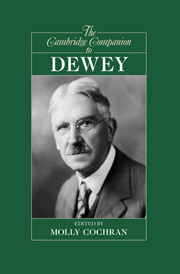Book contents
- Frontmatter
- Introduction
- 1 The making of a democratic philosopher: the intellectual development of John Dewey
- 2 Dewey’s epistemology
- 3 The naturalism of John Dewey
- 4 Dewey’s logic of inquiry
- 5 The primacy of practice in Dewey’s experimental empiricism
- 6 Cognitive science and Dewey’s theory of mind, thought, and language
- 7 John Dewey and action
- 8 Dewey’s moral philosophy
- 9 Ethics as moral inquiry: Dewey and the moral psychology of social reform
- 10 Dewey and pragmatic religious naturalism
- 11 Dewey’s aesthetics
- 12 Dewey’s philosophy of education: a critique from the perspective of care theory
- 13 Dewey’s vision of radical democracy
- 14 Dewey as an international thinker
- Bibliography
- Index
11 - Dewey’s aesthetics
Published online by Cambridge University Press: 28 September 2010
- Frontmatter
- Introduction
- 1 The making of a democratic philosopher: the intellectual development of John Dewey
- 2 Dewey’s epistemology
- 3 The naturalism of John Dewey
- 4 Dewey’s logic of inquiry
- 5 The primacy of practice in Dewey’s experimental empiricism
- 6 Cognitive science and Dewey’s theory of mind, thought, and language
- 7 John Dewey and action
- 8 Dewey’s moral philosophy
- 9 Ethics as moral inquiry: Dewey and the moral psychology of social reform
- 10 Dewey and pragmatic religious naturalism
- 11 Dewey’s aesthetics
- 12 Dewey’s philosophy of education: a critique from the perspective of care theory
- 13 Dewey’s vision of radical democracy
- 14 Dewey as an international thinker
- Bibliography
- Index
Summary
Defining “art” has been a central occupation of philosophers of art throughout the history of the subject. This is quite natural. The range of things that have been talked about and treated as art in one context or another at some time or other is bewilderingly vast, including such items as popular films, Greek urns, experimental poetry, cathedrals, novels high and low, gardens, works of fashion, jokes, string quartets, sonnets, shields, ballets, photographs, and on and on. Reputations, modes of appropriate attention and discourse, places in curricula, and prices in various ways turn on what is treated as art how and when. If it is not the business of philosophers of art to analyze the concept of art so as to sort things out a bit, it is hard to see what their business ought to be. Taking up this business, philosophers have proposed definitions that variously treat (mimetic) representational content, (significantly absorbing) form, (well-wrought and shareable) expressiveness, or certification by accredited authorities as a necessary and sufficient condition for art. Nöel Carroll provides a useful survey of such efforts at definition in his recent Philosophy of Art, concluding, alas, that they one and all founder on counterexamples.
- Type
- Chapter
- Information
- The Cambridge Companion to Dewey , pp. 242 - 264Publisher: Cambridge University PressPrint publication year: 2010
- 5
- Cited by

